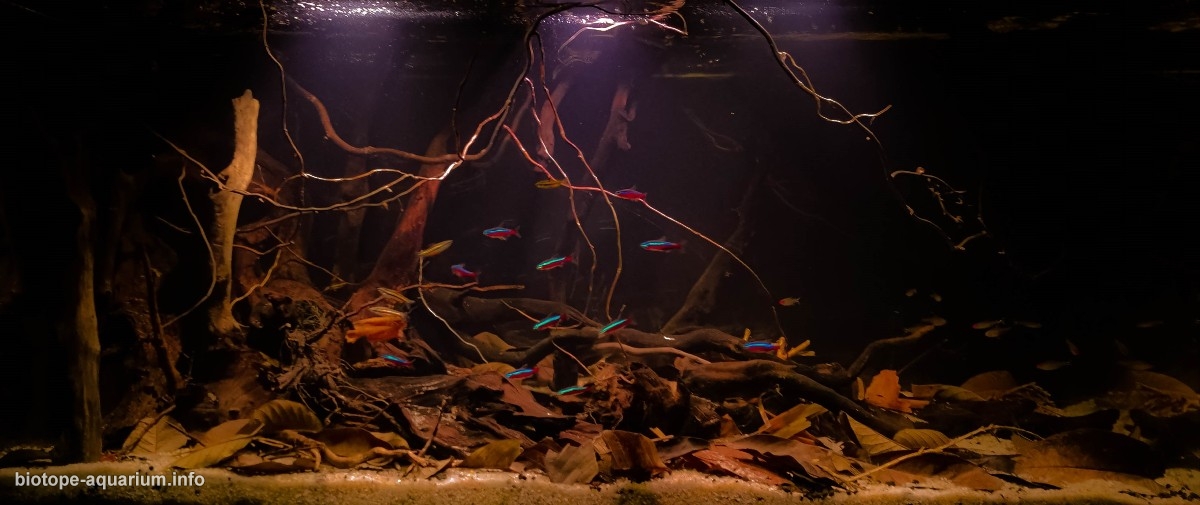Flooded forest at the confluence of the Agua Preta stream in the Unini River, Brazil
53th place in Biotope Aquarium Design Contest 2019
Russia. Albert Vendel

Volume: 145 L
Dimensions: 86x41x52 cm
List of fishes: Nannostomus marginatus, Hemigrammus bleheri, Paracheirodon axelrodi, Hyphessobrycon bentosi
List of plants: –
Description of decorations: Used driftwood of various types in shape and color resemble those that are represented in a natural biotope. Vertical driftwood emphasize that a flooded forest is depicted. To simulate leaf litter, the leaves of Psidium guajava were used. Leaves on the surface are equipped with floats. The basis of the soil is ADA Amazonia, on top is a layer of a mixture of various sand inert to water.
Description of equipment: External filter JBL CristalProfi e902 – 2 pcs, LED spotlight 10 W. – 3 pcs.
Water parameters: Temperature – 25-26°C, pH – 6.5, gH – 1-1.5.
Additional info: The aquarium is the realization of a long-held dream of creating a perfect home for cardinal tetras. It is amazing how much new is revealed in the behavior of fish when conditions are close to natural!
INFORMATION ABOUT BIOTOPE
Description of the area surrounding the biotope: The biotope is a classic black-water flooded area of the forest during the rainy season in the Rio Unini Nature Reserve (Barcelos, Amazonia). Such places here are called “Igapo” and they occupy up to 11% of the reserve. Igapo are seasonally flooded with fresh water, sometimes trees can be sunk for up to six months. At a height of 20-25 meters, the crowns of trees cover the water surface by more than a third, which contributes to the formation of dusk. Many fish rush into the flooded areas of the forest, find abundant food here and begin to breed.
Description of the underwater landscape of the biotope: In the Igapo forests, rivers and streams lie on beds of sandy, acidic soils, the nutrient content of which is minimal, which, coupled with a low-oxygen environment, negates the growth of aquatic plants. But local fish are known for their undemanding oxygen content. In addition, the color and acidity of water are caused by acidic organic humic substances that dissolve in water. In dark water, saturated with tannins and covered with the crowns of trees, flocking fish are distinguished by bright, light stripes or spots. The joint finding of the flock is supported by a kind of “light signals” that make it possible to find each other even with a small amount of light. It is thanks to such biological features that many fish in tropical rainforests have acquired a bright color, wandering in packs between the roots, sunken snag and flooring from fallen leaves. Aquarists would have recognized here primarily cardinal tetra and Rhodostomus. This aquarium was created for them.
Description of the parameters of the habitat: Water is clear, “black”, saturated with tannins, temperature ranges from 24-28 degrees, pH 3.5-4.0, oxygen concentration at the level of 2-3 mg/l, electrical conductivity in the region of 18-30 μS/cm.
List of fishes and invertebrates occurring in the nature biotope: Symphysodon Discus, Paracheirodon axelrodi, Nannostomus unifasciatus, Nannostomus eques, Hemigrammus sp., Dicrossus filamentosus, Apistogramma mendezi, Poecilocharax weitzmani, Crenicichla notophthalmus, Crenicichla marmorata, Hemigrammus rhodostomus, Hemigrammus vorderwinkleri, Hemigrammus analis, Nannostomus marginatus.
List of plants found in the nature biotope: No aquatic plants.
Threats to the ecology: If the threat from fishing is controversial, especially in the reserve, then the destruction of the Igape forest habitats is threatened due to human activities. The greatest threat to igapó forests is the construction of hydroelectric dam on tributaries of the Amazon River; during the construction of the dam, they will divert a huge amount of water and dramatically change the hydrology of the Amazon basin and its ecosystems. Since many types of flora in seasonally flooded forests are well adapted to a specific flood schedule, changes in flood patterns and the creation of permanently flooded areas will cause higher tree mortality rates. Deforestation is also a big conservation problem, because the Igapo forests are characterized by slow tree growth due to the low nutrient content in the soil and the high acidity of the soil. Despite the low availability of nutrients, Igapo and other floodplain forests can be biodiversity with some partially endemic species. Due to the chemical composition of the soil and seasonal flooding, trees and other resources tend to grow more slowly after harvesting by people than in other types of Amazonian forests. Accordingly, Igapo forests cannot withstand logging. It is worth considering that in the reserve where the simulated biotope is located, the risk of an aggravation of the ecological situation is lower than in other similar places.
Sources of information:
http://web.evolbio.mpg.de/
https://uc.socioambiental.org/
Die Aquarien- und Terrarienzeitschrift (DATZ), 43 (10): 582-583. Zitatseite; Geisler, R. 1994. Die Neonfische der Gattung Paracheirodon.
